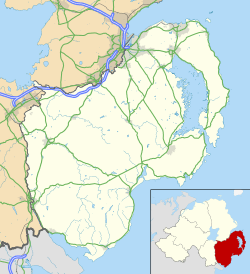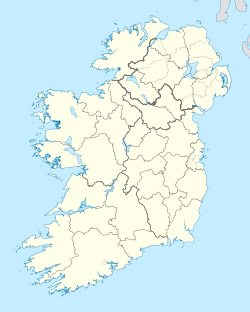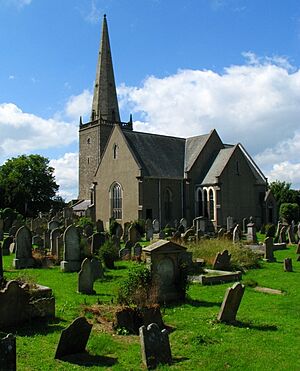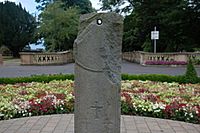Bangor Abbey facts for kids
| Mainistir Bheannchair | |

Model of Bangor Abbey in AD 688
|
|
| Monastery information | |
|---|---|
| Other names | Bennchor; Vallis Angelorum; White Choir |
| Order | Celtic monasticism Augustinian Canons Regular |
| Denomination | Catholic |
| Established | AD 552–559 |
| Disestablished | 1539 |
| Reestablished | c. 1123–24 |
| Mother house | Armagh Abbey (as an Augustinian monastery) |
| Diocese | Down |
| People | |
| Founder(s) | Comgall |
| Architecture | |
| Functional Status | Buildings incorporated into Church of Ireland church |
| Heritage designation | Grade B+ listed building |
| Style | Celtic monastic |
| Site | |
| Location | Bangor, County Down |
| Country | Northern Ireland |
| Coordinates | 54°39′22″N 5°40′30″W / 54.656°N 5.675°W |
| Public access | yes |
Bangor Abbey was a very important monastery founded by Saint Comgall around the year 558. It is located in Bangor, County Down, in Northern Ireland. This abbey was famous for its great learning and strict rules. It's important not to mix it up with another, slightly older abbey in Wales that is now Bangor Cathedral.
Contents
History of Bangor Abbey
How Bangor Abbey Started
Saint Comgall started the monastery at Bangor around 558 AD. It was built in County Down, right on the southern shore of Belfast Lough. Old records, called Annals, have slightly different dates for when it began. They mention years between 552 and 559. The oldest records, like the Annals of Tighernach, say it was founded in 558 AD.
The name "Bangor" was sometimes written as "Beannchor." People also called the place the "Vale of Angels." This was because of a popular story that St. Patrick once rested there and saw the valley full of angels.
Comgall was born in Antrim in 517. He studied at Clooneenagh and Clonmacnoise. At that time, many people in Ireland wanted to live a monastic life. They sought quiet places to serve God. Comgall first went to a lonely island. But his friends convinced him to leave. Later, he founded the monastery of Bangor.
Under Comgall's leadership, the rules were very strict. The monks prayed and fasted all the time. Their food was simple and not much. Worship was the most important part of their daily life. It is clear that music was a big part of how the Bangor monks worshipped. Many people came to join their way of life and to learn.
A Famous School of Learning
Bangor Abbey is considered one of the most important early Irish monasteries. Some say it was second only to Armagh. Inside its large walls, students learned many subjects. These included scripture, theology, logic, geometry, arithmetic, music, and classic texts.
Mo Sinu moccu Min was the fifth abbot of Bangor. It is believed that he taught Columbanus. A historian named Robin Flower wrote that Bangor paid special attention to history. He thought that the earliest Irish history book was probably written there.
Bangor was a major center for learning. It was even called the "Light of the World." Many missionaries, who traveled to spread their faith, were trained there. Carthach of Lismore and Fintan of Doon both studied at Bangor. Saint Mirin was a leader at Bangor before he left to start Paisley Abbey in Scotland.
Two very famous monks, Columbanus and Gall, left Bangor in 590 AD. They traveled to Europe. There, they founded important monasteries like Luxiell in France, St Gallen in Switzerland, and Bobbio in Italy.
When Bangor Abbey Declined
Like many old Irish monasteries, Bangor was destroyed and rebuilt several times. Records show that Bangor was burned in 616 and again in 755. At that time, the buildings were likely made of wood.
Because it was easy to reach from the sea, Bangor was often attacked. Between 822 and 824, the Norsemen, also known as Vikings, attacked and robbed it. Records say that during this raid, "learned men and bishops" were killed. The special box holding the remains of Comgall was also taken. Another person likely killed by the Vikings was Tanaidhe MacUidhir, a leader of Bangor, in 958. Most historians agree that Bangor's importance started to fade around the late 900s.
In 1121, St. Malachy became the Abbot of Bangor. He had to rebuild everything from scratch. However, just three years later, he became the Bishop of Down. After he left, Bangor fell into ruin again. Later, a law called the Statutes of Kilkenny stopped "mere Irishmen" from joining the monastery there.
In 1469, the Franciscans took over the abbey. A century later, the Augustinians had it. Then, when monasteries were closed down in that part of Ireland, King James I gave it to Sir James Hamilton. He fixed up the church in 1617 and was buried there when he died in 1644. It seems that stones from the old abbey were used to build the new church. Today, all that is left of the original abbey is a wall known as St. Malachy's Wall.
The current Tower of the church dates back to the 14th century. Inside the church, there is a painting of Christ going up to heaven. Saints Comgall, Gall, and Columbanus are shown at his feet.
The Antiphonary of Bangor
The Antiphonary of Bangor is a very old book. It was probably written by the monks of Bangor Abbey between 602 and 691. For over 1000 years, it was kept at Bobbio in Italy.
This book contains a collection of Latin hymns, prayers, and songs. It is one of the oldest surviving monastic books from Ireland that we can date. People describe it as one of the most valuable things we have from the early Irish church. The Antiphonary gives us important clues about what monastic life was like in Ireland. It also shows how skilled the monks of Bangor were in art and writing in the seventh century.
Today, none of the original buildings from Comgall's monastery are left. However, in a private chapel at Clandeboye, you can see part of a Cross built into the wall. This piece was found in the abbey area. It is a fragment of a Celtic High Cross, which might have stood on "the Cross Hill" near Bangor Castle. An old map from the 1600s shows this spot. This piece of the cross probably dates from around the 8th century.
Gallery
See also
 In Spanish: Abadía de Bangor para niños
In Spanish: Abadía de Bangor para niños
- Abbeys and priories in Northern Ireland (County Down)








